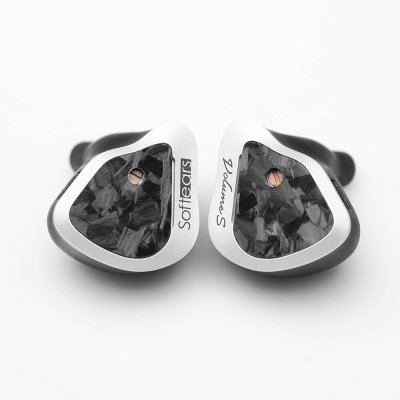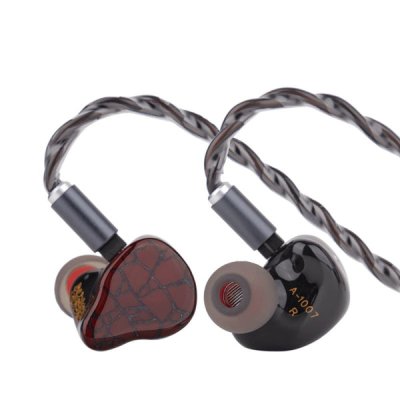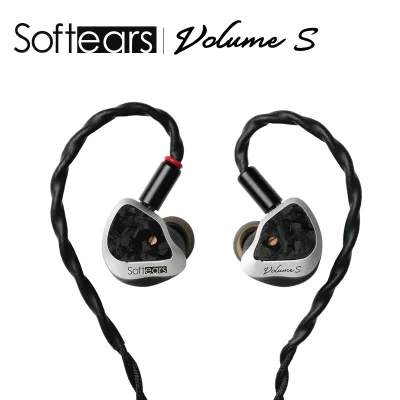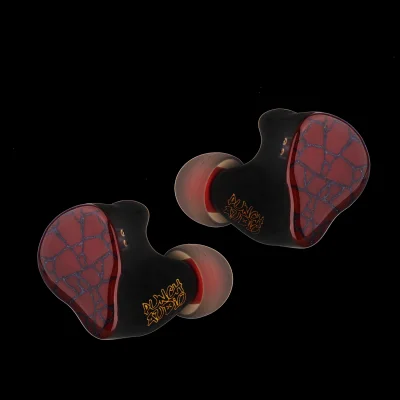Softears Volume S and Punch Audio Martilo use 2DD+2BA and 2DD+2BA+1Planar driver setups respectively. Softears Volume S costs $320 while Punch Audio Martilo costs $329. Punch Audio Martilo is $9 more expensive. Softears Volume S holds a slight 0.2-point edge in reviewer scores (7.8 vs 7.6). Softears Volume S carries a user score of 8.2. Softears Volume S has slightly better bass with a 0.3-point edge, Softears Volume S has better mids with a 0.5-point edge, Softears Volume S has better treble with a 0.5-point edge, Punch Audio Martilo has significantly better dynamics with a 3-point edge and Softears Volume S has better soundstage with a 0.5-point edge.
Insights
| Metric | Softears Volume S | Punch Audio Martilo |
|---|---|---|
| Bass | 8.3 | 8 |
| Mids | 7.5 | 7 |
| Treble | 7.5 | 7 |
| Details | 6.5 | 7.6 |
| Soundstage | 8 | 7.5 |
| Imaging | 6.5 | 7.6 |
| Dynamics | 6 | 9 |
| Tonality | 7.9 | 7.5 |
| Technicalities | 7.5 | 7.2 |
Softears Volume S Aggregated Review Score
Average Reviewer Scores
Average Reviewer Score:
7.8Strongly Favorable
Punch Audio Martilo Aggregated Review Score
Average Reviewer Scores
Average Reviewer Score:
7.6Strongly Favorable
Reviews Comparison
Softears Volume S reviewed by Jaytiss
Jaytiss Youtube Channel
Buy Softears Volume S on HiFiGO
Ad
Price: $290
Buy Softears Volume S on HiFiGO
Punch Audio Martilo reviewed by Jaytiss
Youtube Video Summary
Punch Audio Martilo steps in as a new-brand debut with a confident package: a hybrid array (planar + BAs + DDs), a metal nozzle, proper venting, and a recessed 2-pin socket set into a shell that sits securely thanks to an anti-tragus catch. The faceplate gives off AFUL Performer 7 vibes, the included cable is supple with clear R/L markings, and the textured carry case plus two tip sets round out a thoughtful accessory kit. Priced around $329—with occasional deep discounts during big Linsoul sales—build and accessories feel dialed in for the bracket.
Sonically, this is a bassy set that still behaves like an all-rounder. The bass shelf rises from roughly ~150 Hz, bringing weight and warmth without turning podcasts and vocals into mud; upper-mids are present yet controlled, minimizing shout, while mid-treble energy keeps things crisp. Female vocals avoid huskiness, note weight is satisfying, and the tuning strikes a balanced, fun profile that works across genres. On the graph it hugs a safe line, then sprinkles in extra low-end for flavor—bass-head friendly, but not a blunt instrument.
In A/Bs, it addresses the AFUL Explorer’s softness with more bass and mid presence, and compared to similarly priced Kiwi Ears Astral (the safer neutral pick), Martilo offers the spicier, more engaging option. Against “specialist” bass sets like Deuce or Quantum, Martilo feels cleaner in the mids, less abrupt in its slam, and more universally usable; versus warmer bass champs (e.g., Mega 5 Bass), it trades some warmth for clarity and refinement. This isn’t sterile “audiophile-neutral”—it’s audiophile-fun done with taste. Scoring reads like: bass (10/10), note weight (10/10), mids (9/10), with surprisingly solid highs, stage, and imaging for the money. Not flawless, but distinctive, well-tuned, and easy to recommend—especially for listeners who want real bass without sacrificing everyday versatility.
Jaytiss Youtube Channel
Buy Punch Audio Martilo on Linsoul
Ad
Price: $329
Buy Punch Audio Martilo on Linsoul
Softears Volume S reviewed by Gizaudio Axel
Gizaudio Axel original ranking
Gizaudio Axel Youtube ChannelPunch Audio Martilo reviewed by Gizaudio Axel
Youtube Video Summary
Boom — time for bass. Punch Audio’s Martilo is a tribrid (2×8 mm DD + 2 BA + 1 micro planar) coming in around $330. The package is stacked: sturdy square case, extra filters, multiple tip sets, and a genuinely excellent modular 3.5/4.4 cable that lays flat, has no microphonics, and a firm chin slider. The shells are ergonomic with venting, metal nozzles with a proper lip, and a small nozzle diameter (5.9/5.0 mm) that helps seal; comfort and passive isolation are both strong.
Sonically, this is unapologetically bass-focused without being bass-only. Expect massive sub-bass depth and a punchy mid-bass, yet the low end stays tight, controlled, textured and doesn’t bleed. Mids retain clarity with non-shouty presence, while treble is crisp, smooth, non-fatiguing with decent extension (not ultra-airy). For a bass-heavy set, technical performance is solid: detail is good, and imaging/separation keep busy tracks coherent and energetic.
Against Hisenior’s Mega5EST Bass Plus, Martilo hits harder, feels more engaging, and offers better vocal clarity — and it steamrolls on value at the lower price. Compared with Xenns Tea Pro, the Tea Pro is a bass-lover all-rounder that spotlights vocals/instruments more; Martilo goes full bass-head with bigger rumble and impact. Ideal for listeners who crave deep slam but still want clarity, comfort, and great accessories; not for neutral/reference chasers. Final verdict: 4/5 — it truly punches above its price.
Gizaudio Axel original ranking
Gizaudio Axel Youtube ChannelSoftears Volume S reviewed by Jays Audio
Youtube Video Summary
The Softears Volume S emerges as a standout vocal specialist under $500, often described as a "mini studio 4“ due to similar frequency graphs. However, it trades some treble detail for superior scaling and a heightened focus on the mid-range, particularly vocals, while adding a touch more mid-bass oomph. This treble reduction allows the music to breathe, creating a more immersive and musical experience that pulls the listener deeper into the sound compared to the Studio 4, without sacrificing a sense of space or leaving the bass and treble feeling inadequate. Though not bass-heavy or treble-head oriented, the low-end provides enough thump and the highs enough air to avoid sounding lean or dark, resulting in a presentation that's slightly less technical and balanced than the Studio 4 but excels in vocal delivery and engagement.
A key feature is the tuning switch which boosts upper mids and treble while lowering the bass, effectively transforming the sound into a cleaner, more technical version of Harman 2019, even surpassing the Studio 4 in detail retrieval in this mode. However, this boosted configuration can sound shouty, lean, and overly clinical for many preferences, lacking the thickness of the stock tuning and scaling less effectively at higher volumes. The stock tuning, preferred for its vocal prowess, truly comes alive with increased volume. The included clear tips are recommended for a slight treble lift and comfort, and the bundled USBC adapter adds a subtle amount of sub-bass rumble, though the low-end remains clean and controlled, reminiscent of leaner sets like the Pilgrim, not providing heavy slam.
While the Studio 4 remains a solid, well-balanced all-rounder, especially on sale around $350, and alternatives like the EM10 (more detailed), Supermix 4 (better value), the Volume S carves its niche with exceptional vocal performance at higher volumes using the stock tuning. Its main drawbacks involve the confusing switch design (requiring opposite positions on each earpiece for the same tuning with no clear indicators) and the pricing debate; using non-branded drivers suggests a more appropriate price point would be $200-$250 rather than $300. Despite these quirks and marketing claims about the passive radiator's role (its actual impact being debatable), the Volume S delivers a great sounding, flexible IEM offering distinct sonic profiles based on volume level and switch position.
Jays Audio Youtube Channel
Punch Audio Martilo reviewed by Jays Audio
Jays Audio Youtube Channel
Softears Volume S reviewed by Z-Reviews
Youtube Video Summary
The Softears Volume S offers a dramatic transformation through its impedance switch, requiring a tiny screwdriver to toggle between low (9.8 ohm) and high (31.2 ohm) modes. The low impedance mode is described as painfully clinical, bland, and annoyingly sterile across all tested amplifiers. It’s reminiscent of the disliked original Volume model, lacking any enjoyable tuning despite EQ attempts. This mode only suits listeners craving absolute neutrality, offering little musical engagement.
Switching to the high impedance mode completely revolutionizes the experience. It becomes relaxed, unoffensive, and remarkably smooth, with notes possessing a lingering, church-like resonance that adds emotional depth. This mode presents music with a spacious, uplifting quality and a subtle chest-felt pressure during resonant passages. However, it demands quality amplification to shine and benefits from tip-rolling; the included sticky liquid silicone tips enhance the signature, though alternatives like Azla SednaEarfit can tweak the response. Comfort and build are excellent, though the fabric cable exhibits some microphonics.
Priced around $300, the Volume S earns a cautious recommendation primarily for its stellar high-impedance performance. It requires tinkering with tips and sources to reach its potential and faces stiff competition in its price bracket. While not an outright class leader, it’s a significant upgrade over the original Volume. The package includes a luxurious case, multiple tips, and a branded USB-C adapter, reflecting Softears' typical attention to detail. Just keep it locked in high-impedance mode.
Z-Reviews Youtube Channel
Punch Audio Martilo reviewed by Z-Reviews
Youtube Video Summary
The Punch Audio Martilo shows up screaming BASSHEAD on the box, but the tuning is smarter than that. A hybrid stack—2×8 mm DD + 2×BA + 1 planar—delivers bass that hits when the track calls for it, then gets out of the way. The surprise is the huge soundstage: airy, wide, borderline cinematic, so pianos, crowds, and live recordings feel expansive rather than claustrophobic. Low 9 Ω impedance and easy efficiency keep the power demands chill, though a low-impedance cable is recommended.
Tip rolling matters. With thin-wall silicone (e.g., Dunu S&S) the stage opens up and balance feels right; foams and some wide-bore options can push treble into a slightly sharp zone on certain tracks. Tonality reads clean and natural—warm-adjacent without a blanket—so everyday music stays unbloated, while proper sub-bass test tracks pressurize with that “firm hand on the chest,” not a sledgehammer.
Build is solid: thick, comfy modular cable with swappable plugs, flashy red shells, and a comically oversized box for a modest accessory set (silicone + foams). Street price around $330 lands in the sweet spot—easily justifying $375 by ear. Think “poor man’s Mega 5 EST Bass Plus”: similarly satisfying slam and stage, with the pricier set showing a touch more upper-mid/treble refinement. Not just for bassheads—more like a full-range thrill ride that lets music breathe and hit when it should.
Z-Reviews Youtube Channel
Softears Volume S reviewed by Tim Tuned
Youtube Video Summary
The Softears Volume S delivers a distinctly colored sound signature with significant boosts in two key areas: the bass and the upper mid-range. Its bass profile is uniquely elevated up to around 300Hz, resulting in a physical, heavy, yet well-defined low end that impresses with substantial note weight and attack, appealing even to bass enthusiasts. Vocals cut through clearly due to the upper mid-range boost, but this tuning comes with a trade-off: a noticeable sense of hollowness and a narrower soundstage that can feel congested on certain tracks, creating a love-hate relationship with its presentation.
The treble offers a safe, natural, and polite character, providing adequate detail without excessive brightness or roll-off, though it may lack sparkle for some listeners. Technically, the Volume S performs at a level comparable to the Moondrop Blessing 3, excelling particularly in the incisive attack and substantial weight behind each note. When compared to competitors, the Volume S edges out the Tea Pro in bass quality, separation, and natural timbre, though the Tea Pro offers a wider stage. Against the Blessing 3, the Volume S trades openness and cleanliness for a more fun, bass-forward and impactful experience. It also presents a more balanced signature than the brighter, more treble-focused Kiwi Ears Astral.
Ultimately earning an A-minus rating, the Volume S is highly recommended for those seeking exceptional bass quality and a fun, colored tuning. However, it might not suit listeners prioritizing a wide soundstage, a neutral signature, or a bright, sparkly treble with forward micro-details; these listeners are advised to audition first.
Tim Tuned Youtube Channel
Punch Audio Martilo reviewed by Tim Tuned
Tim Tuned Youtube Channel
Softears Volume S reviewed by Head-Fi.org
Punch Audio Martilo reviewed by Head-Fi.org
Softears Volume S (more reviews)
Softears Volume S reviewed by Audio Amigo
Youtube Video Summary
Softears Volume S follows the 2022 Volume and steps into a fiercely competitive ~$320 bracket with a seriously premium kit: a gorgeous leather case, modular screw-on terminations, both standard and Ultra Clear eartips, IM booties, and tiny screwdrivers for the on-board potentiometer. The stealthy black resin shells with exposed carbon-fiber faceplates feel solid and fit well thanks to slim nozzles; just note there’s no nozzle mesh. The big caveat is the cloth-sheathed stock cable—ergonomically nice but with heavy microphonics. Two tunings are selectable: low-impedance (≈10Ω) and high-impedance (≈31Ω). The low-impedance mode is the keeper; it’s easy to drive yet sensitive to source output impedance, so a dongle under 1Ω is recommended to avoid unintentionally shifting the tonality.
In low-impedance mode the signature is neutral-natural, a flatter, more mid-centric take on “new-meta.” Bass offers quality over quantity: textured, punchy, and responsive without tipping into basshead territory. The mids are the star—clean, warm-tinged lower mids give male vocals body while female vocals sit forward without shout, keeping timbre natural. Treble is smooth, airy, and non-fatiguing, avoiding metallic glare while preserving sparkle. Technical performance is confidently above average for the price: imaging & stage feel wide and well-layered, with good separation and resolution that rewards attentive listening without forcing it.
Positionally, think “Kato upgrade”: smoother treble, better bass texture, and a refinement that many will prefer. Versus spicier rivals like DaVinci, Project Meta, Dusk DSP, or Mega 5 EST, the Volume S sounds more controlled and “correct,” trading some slam and upper-air fireworks for coherence and timbre. It won’t thrill bass lovers, treble heads, or detail chasers seeking a spotlighted presentation; everyone else gets a superb all-rounder that feels benchmark-worthy—the HD600/650 vibe for IEMs. Verdict: you should buy this if a do-it-all, neutral-natural tuning is the goal; just mind your source impedance and consider swapping the cable to kill the microphonics.
Audio Amigo Youtube Channel
Softears Volume S reviewed by Super* Review
Youtube Video Summary
The Softears Volume S at $320 sets a new tonal benchmark for IEMs in its price range. It arrives in solid packaging featuring a zippered carry case (a bit large but functional), protective earpiece pockets that might feel overkill for some, and two excellent sets of ear tips – including Softears' own highly-regarded Ultra Clear tips. Build quality is generally fantastic, highlighted by a resin shell, a comfortable paracord-style cable with a low-profile, user-swappable termination system, and recessed 2-pin connectors. While the aesthetics might feel a bit old-school to some, the fit is comfortable and stable due to its semi-custom shape and longer nozzle, making it secure enough for sleeping. A small screwdriver-adjustable tuning switch offers a secondary, brighter Harmon-like sound signature, though the default tuning is preferred.
The default sound signature is a warm-tilted neutral, delivering exceptional natural timbre and tasteful bass boost. This bass stands out for its exceptional physicality – punchy and impactful without being overbearing – alongside articulate sub-bass that’s easy to follow. Combined with well-defined transients, particularly in the upper-midrange, it creates a satisfyingly rich and dense presentation. While spatial effects and imaging are competent but not standout, the overall tonality and bass quality are remarkably refined. Comparisons show it offers a better tonal balance and bass control than the bassier Dunu DaVinci, significantly more body and richness than the brighter, thinner Moondrop Blessing 3, and trades blows with the Moondrop Dusk – the Volume S providing superior density and mid-bass presence versus the Dusk's more open, spacious presentation.
Ultimately, the Softears Volume S earns a full five-star rating. It might not be the absolute most technically dazzling IEM, but its fantastic tonal balance, unique bass physicality, and overall refinement make it a compelling choice. For $320, it delivers a sound signature that feels just right – rich, satisfying, and universally appealing – challenging more expensive offerings and establishing itself as a top contender in its class.
Super* Review original ranking
Super* Review Youtube ChannelSoftears Volume S reviewed by Audionotions
Softears Volume S reviewed by
 Fresh Reviews
Fresh Reviews
Youtube Video Summary
The Softears Volume S delivers a fantastic hybrid sound in its low impedance mode, characterized as a warm neutral tuning with a lush note weight, good bass punch without bloat, and a slight upper-midrange emphasis that makes vocals pop. This signature translates exceptionally well across both music listening and competitive gaming, offering great separation, layering, and phenomenal imaging for precise positional awareness. While engaging and non-fatiguing, gunfire and intense effects in games like Apex Legends can sometimes feel on the verge of shouty or slightly occlusive during chaotic, high-level scenarios, lacking that last bit of air and resolution in the upper mids.
Gaming performance shines across multiple titles. The Volume S provides outstanding depth perception and accurate imaging for Apex Legends slides and light footsteps, excels in Valorant with its separation and verticality, handles the chaos of Call of Duty exceptionally well, and proves to be a top recommendation for Fragpunk due to its loud, precise, and easily trackable footsteps. The smaller resin chassis offers great comfort and ergonomics, especially for those struggling with fit, though it doesn't feel quite as premium as some metal competitors in its price range.
Significant drawbacks include the utterly dismissed high impedance mode tuning, deemed "absolute garbage" and a headache for gaming, and the fragile tuning mechanism itself, prone to easy damage. The included shoelace-style cable is functional with a removable termination but not a favorite, and the unboxing experience, while decent with a pleather case, extra termination, and two sets of silicone tips, is fairly typical for the price. Ultimately, the Softears Volume S stands as a killer all-around IEM when locked into its excellent low impedance mode, highly recommended for its crossover appeal despite the useless tuning switch and build quibbles.
Fresh Reviews original ranking
Fresh Reviews Youtube ChannelSoftears Volume S reviewed by Smirk Audio
Punch Audio Martilo (more reviews)
Punch Audio Martilo reviewed by Bad Guy Good Audio
Youtube Video Summary
Punch Audio Martilo hits the brief for bass-centric listeners. The tuning kicks up from ~200 Hz, driving a potent low end, then rides a flat porch through the mids with a gentle ear-gain that crests around 3 kHz before easing off. It mirrors the well-known Kiwi Ears collab curve but with a touch more upper-mids energy for cleaner, clearer vocals. At $279 with the card (and still competitive around $320), this set undercuts many rivals and, for libraries heavy on rock and hip-hop, feels purpose-built.
The hybrid stack—2DD + 2 BA (branded) with a planar on top—keeps the upper-mids sensible and lets the treble play from roughly 5 kHz+ without glare. Personal preference might lean to EST or a high-end BA super-tweeter, but here the planar’s implementation stays out of trouble by avoiding an overcooked 1–3/4 kHz shelf. Result: strong slam, stable mids, and treble that’s present yet subordinate to the preceding bands—focused on transparency rather than flash.
Beyond sound, the packaging and cable show real forethought—distinct from the usual cookie-cutter unboxings—and the overall execution reads like a brand finally dedicated to the low-end community. With more models in the pipeline (including a budget single DD and a planar+DD combo), Martilo arrives as a market shaker for bass lovers seeking muscle without muddying the mids. For the asking price, it’s an easy recommendation to audition—especially if the playlist is built on rhythm sections and big grooves.
Bad Guy Good Audio original ranking
Bad Guy Good Audio Youtube ChannelPunch Audio Martilo reviewed by Web Search
The Punch Audio Martilo delivers a powerful bass experience that dominates its signature, featuring a substantial 14dB sub-bass boost. This emphasis creates visceral, physical rumble, especially in electronic or hip-hop tracks, yet avoids overwhelming the lower mids due to a precise 200Hz crossover. While the dual dynamic drivers generate impressive slam and texture, a slight bloom can occasionally creep into the low-mids on very busy tracks, though it generally maintains better control than many bass-focused rivals.
Surprisingly, the midrange retains clarity and naturalness despite the bass foundation, handled competently by the Knowles balanced armatures. Vocals, both male and female, sound full-bodied and avoid the huskiness or recession common in bass-heavy tunings, while instruments like guitars retain decent texture. The planar magnetic driver contributes a smooth, non-fatiguing treble with adequate air and detail retrieval, though it doesn't quite reach the sparkle or ultimate extension of dedicated electrostatic tweeters.
Technical performance is solid for its price and tuning goal, offering a wide soundstage with good depth and effective layering, particularly impressive given the bass quantity. Imaging is precise enough for accurate placement of instruments. While the bass is the star, the overall presentation manages to avoid being a one-note experience, offering a fun yet reasonably balanced listen that works across more genres than typical basshead sets.
Softears Volume S Details
Driver Configuration: 2DD+2BA
Tuning Type: Neutral with Bass Boost
Brand: Softears Top Softears IEMs
Price (Msrp): $320
Support our free service! Buying through our affiliate links costs you nothing extra:
Punch Audio Martilo Details
Driver Configuration: 2DD+2BA+1Planar
Tuning Type: Basshead
Price (Msrp): $329
Support our free service! Buying through our affiliate links costs you nothing extra:
Softears Volume S User Review Score
Average User Scores
Average User Score:
Based on 2 user reviews
8.2Very Positive
Punch Audio Martilo User Review Score
Average User Scores
Average User Score: n/a
Based on 0 user reviews
No user reviews yet. Be the first one who writes a review!
Softears Volume S Gaming Score

Gaming Score & Grade
- The gaming score is prioritizing technical capabilities of the IEM (Separation, Layering, Soundstage) and good value.
Gaming Score
8.4Gaming Grade
A+Punch Audio Martilo Gaming Score

Gaming Score & Grade
- The gaming score is prioritizing technical capabilities of the IEM (Separation, Layering, Soundstage) and good value.
Gaming Score
7Gaming Grade
A-Softears Volume S Scorings
Average Technical & Tuning Grades
Average Tunign Grade
A- Tuning feels well executed, keeping a natural flow across the spectrum. Switching genres feels seamless.
Average Technical Grade
A- You get a well-rounded technical package that keeps separation, detail, and staging in harmony. It's a solid middle ground between fun and fidelity.
Punch Audio Martilo Scorings
Average Technical & Tuning Grades
Average Tunign Grade
A- You get a polished tonal profile that stays natural from bass through treble. Subtle tuning choices keep things engaging.
Average Technical Grade
A-- Technical chops are reliable, pairing tidy separation with a soundstage that stays conservative. Micro-detail is decent, though never spotlighted.
Softears Volume S User Reviews
Share your experience and build your personal ranking list.
You need to be signed in to write your own reviewA well-rounded, coherent IEM that shines in low-impedance tuning with excellent midrange clarity.
Pros
Balanced, natural midrange with solid bass and rich accessories.Cons
High-impedance mode feels unnecessary and shells may be bulky for small ears.RSV with more bass quantity and better quality, at less than half the price.
Pros
Very nicely balanced sound signature for all-rounder duties, with tonality and technical performance that punches above its price. More even sub - mid bass profile which results in a more cohesive, better textured bass vs harman/meta tuned sets.Cons
Pinna gain isn't an ideal fit for my HRTF, hearing slightly too much upper-mid emphasis after extended listening and comparisons. Upper treble is lacking air vs more expensive sets, most evident in cymbal hits coming across dulled, not unlike the RSVPunch Audio Martilo User Reviews
"This is an example review"
Pros
- Example pro 1
- Example pro 2
Cons
- Example con 1
- Example con 2
Share your experience and build your personal ranking list.
You need to be signed in to write your own reviewFind your next IEM:
IEM Finder Quiz
newIEM Comparison Tool
newVS




























